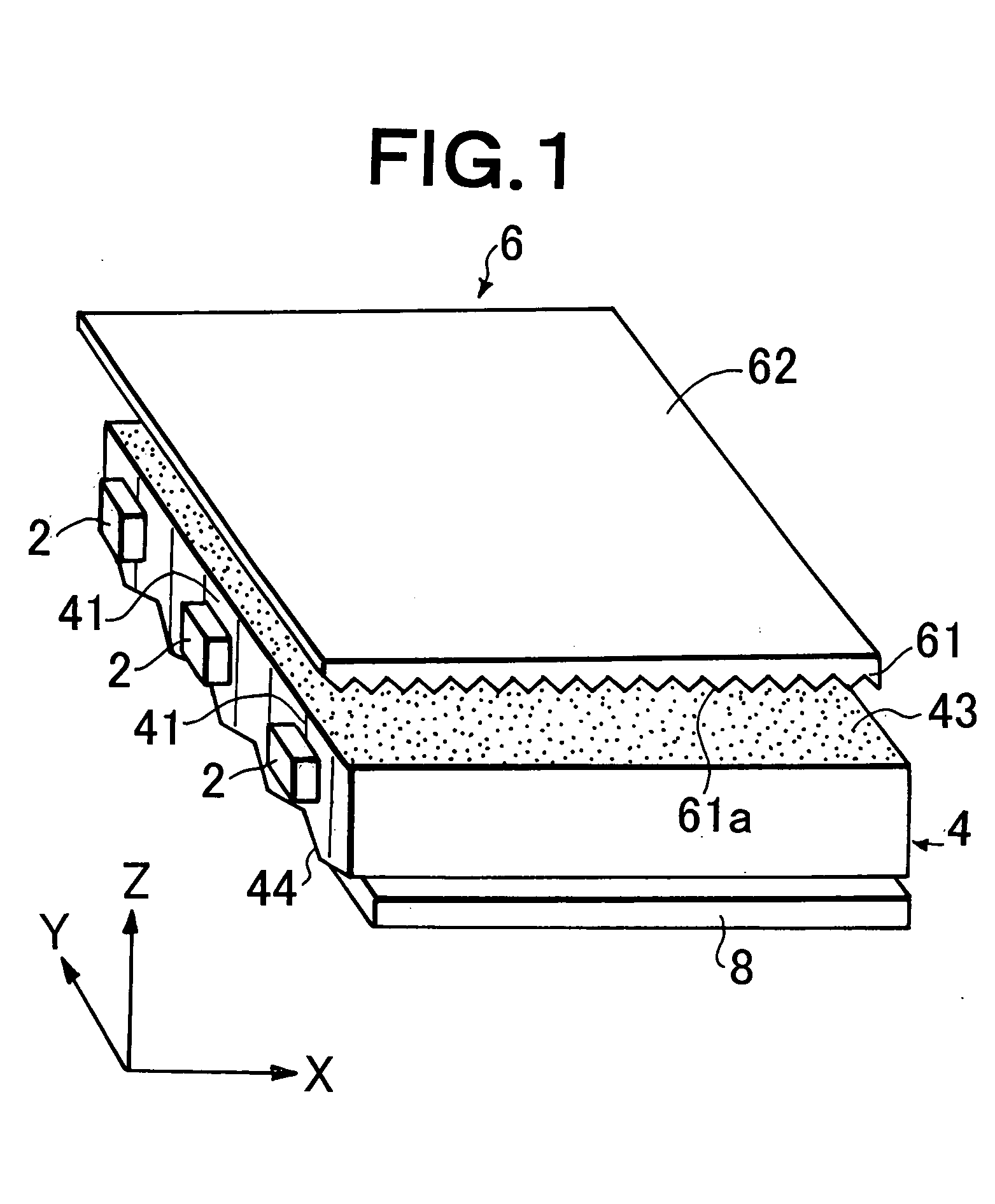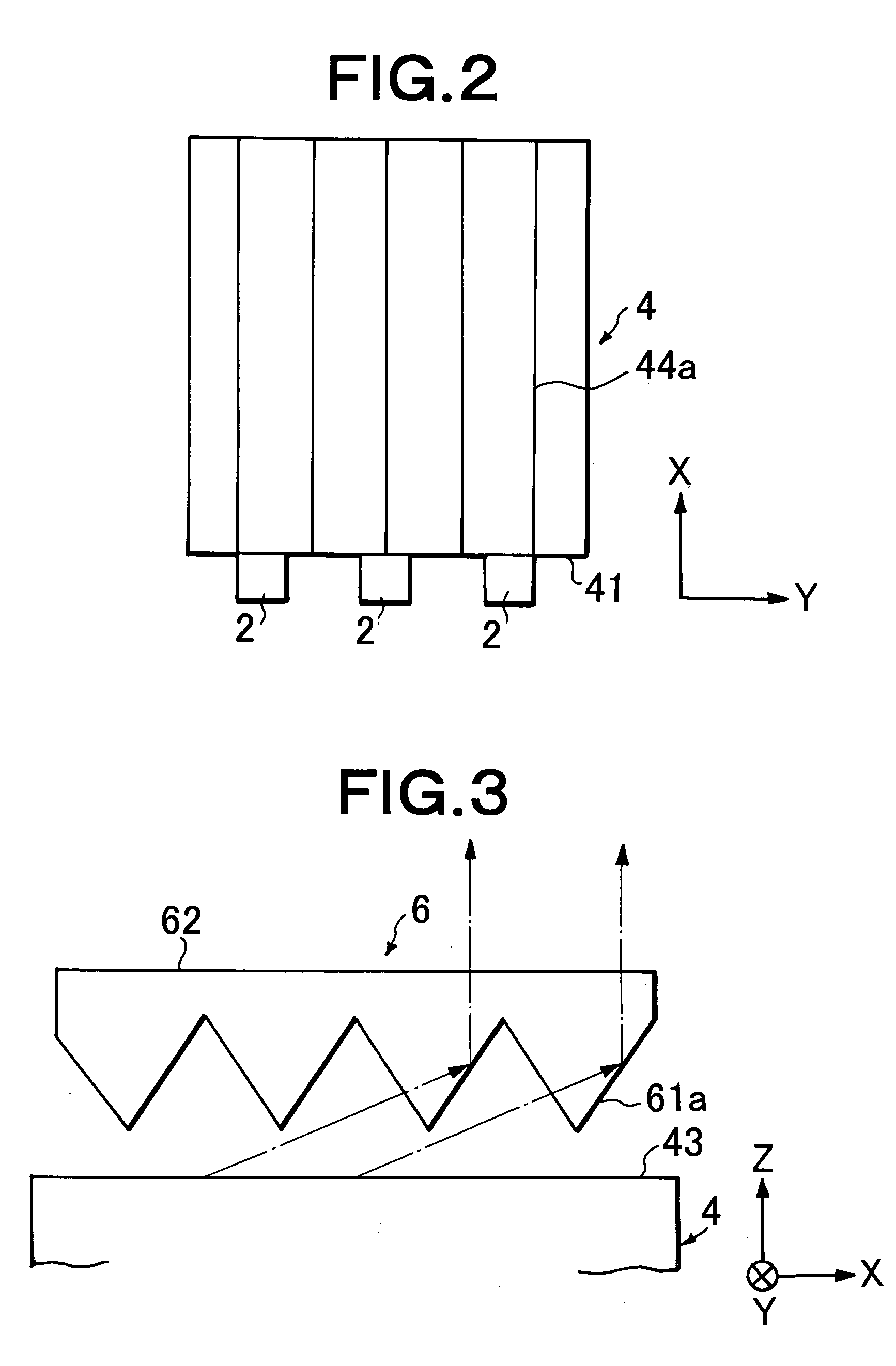Surface light source device and light guide used therefor
a light source and surface technology, applied in the direction of planar/plate-like light guides, lighting and heating apparatus, instruments, etc., can solve the problems of uneven brightness distribution of luminance in observation directions, disproportionate brightness, and easy drop of luminance in these portions or regions, so as to reduce power consumption, eliminate various brightness unevenness, and high quality level
- Summary
- Abstract
- Description
- Claims
- Application Information
AI Technical Summary
Benefits of technology
Problems solved by technology
Method used
Image
Examples
examples
[0161] Examples and comparative examples of the present invention will be described. It is to be noted that in the examples and comparative examples, to measure a micro region inclination angle of a light guide cross-sectional shape, a replica of a elongated lens forming surface of a light guide was prepared, the replica was cut by the surface perpendicular to an extending direction of a elongated lens, and the measurement was performed based on a cross-sectional shape line obtained by enlargement of a cut end surface with an optical microscope, electron microscope or another image pickup means. Calculation of a histogram or degree distribution of an absolute value of the micro region inclination angle, and calculation of a valley portion inclination angle were performed in the same manner as described above with reference to FIGS. 6A and 6B. Additionally, when the cross-sectional shape was equally divided to set the micro regions as described above, the measuring of a coordinate of...
example 1
[0164] The surface of a stainless steel plate worked into a mirror surface and having an effective area of 34 mm×48 mm, and a thickness of 3 mm was partially roughened by a blasting process performed with respect to a region excluding a region of 3.5 mm from a side having a length of 34 mm, using glass beads having a particle diameter of 53 μm or less (FGB-400 manufactured by Fuji Seisakusho Co., Ltd.), and setting a distance from the stainless steel plate to a blowing nozzle was 32 cm and a blowing pressure was 5 kgf / cm2. Accordingly, a first mold having a shape transfer surface which was partially a rough surface was obtained.
[0165] On the other hand, a symmetrical lens pattern in which elongated lenses having a pitch of 50 μm were arranged in parallel to a side having a length of 48 mm was formed on the surface of a brass plate worked into a mirror surface and having an effective area of 34 mm×48 mm and a thickness of 3 mm by cutting. Accordingly, a second mold having the shape ...
example 2
[0193] This example was performed in the same manner as in Example 1 except that a blasting process of a first mold was performed with respect to a region excluding a region of 3.0 mm from a side having a length of 34 mm, a blowing pressure in this case was changed in a range of 4 kgf / cm2 to 6 kgf / cm2, a blasting process of a second mold was performed with respect to the region excluding the region of 3.0 mm from the side having a length of 34 mm, and a blowing pressure in this case was set to 1.5 kgf / cm2.
[0194] An average inclination angle of a light outputting surface of an obtained light guide was 0° in a region of 3.0 mm from a light incident end surface, and 2.5° to 3.5° in the other region, and a middle portion of an effective light emitting region had a maximum value.
[0195] The cross-sectional shape of the elongated lens forming surface of the obtained light guide was as follows. [0196] (Region A: region of 3.0 mm from light incident end surface) [0197] Outward convex curve...
PUM
 Login to View More
Login to View More Abstract
Description
Claims
Application Information
 Login to View More
Login to View More - R&D
- Intellectual Property
- Life Sciences
- Materials
- Tech Scout
- Unparalleled Data Quality
- Higher Quality Content
- 60% Fewer Hallucinations
Browse by: Latest US Patents, China's latest patents, Technical Efficacy Thesaurus, Application Domain, Technology Topic, Popular Technical Reports.
© 2025 PatSnap. All rights reserved.Legal|Privacy policy|Modern Slavery Act Transparency Statement|Sitemap|About US| Contact US: help@patsnap.com



